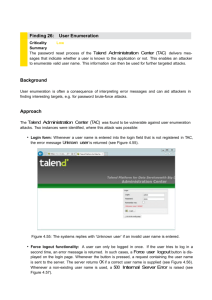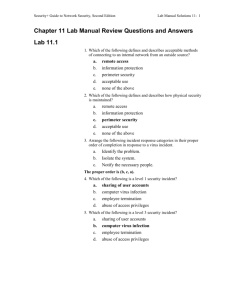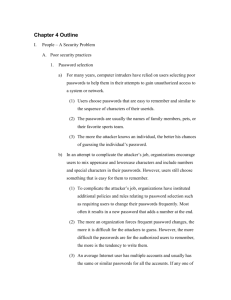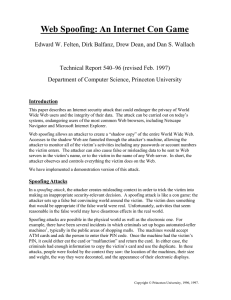Papers on Web-based Fraud and Identity Theft
advertisement
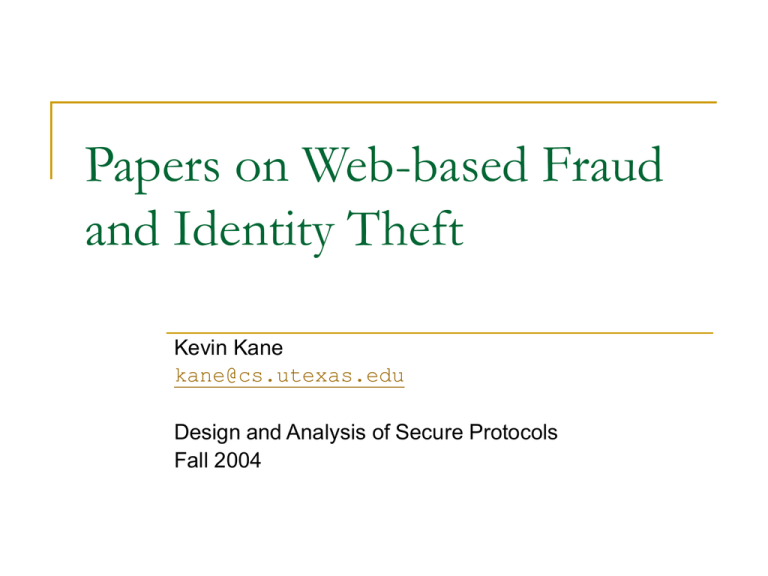
Papers on Web-based Fraud and Identity Theft Kevin Kane kane@cs.utexas.edu Design and Analysis of Secure Protocols Fall 2004 “Web Spoofing: An Internet Con Game” Edward W. Felten, Dirk Balfanz, Drew Dean, and Dan S. Wallach Let’s be clear on the context: paper written in February 1997 Main point: Given an attacker-created “shadow copy” of the World Wide Web, an attacker can: monitor a user’s activities including passwords and account numbers Send false or misleading data in the victim’s name The attacker does not really copy the whole web, but interposes himself between the victim and the Web Spoofing Attacks Create a “misleading context,” which tricks the victim into making an inappropriate security-relevant decision The decision would be appropriate, if the context were really what it claimed to be Example: Bogus automated teller machines capture card numbers and inputted PINs for an attacker, then pretend to experience a fault so as to appear just as a malfunctioning machine What is a “context” on the Web? Visual cues about a page’s origin Site name from URL in the Location bar to deduce source File name from URL to deduce file type or function Text and images on the page, such as a logo Unique appearance of the page, such as an unconventional color scheme indicative of one particular source Temporal locality: events occurring close in time are usually related All of these cues can be unreliable! Web Spoofing The attacker controls the false web, and so can conduct: Surveillance. Pages viewed and form data sent are intercepted by the attacker. Tampering. Attacker does not have to relay victim’s requests and responses correctly: data can be falsified for modified in-transit from the victim, or from the responding web server on the “real” web. Spoofing the Whole Web The Man in the Middle Attack URL rewriting Prepend all URL’s with the attacker’s host so that requests are routed through it http://home.netscape.com/ becomes http://www.attacker.org/http://www.server.com/ Pages are then requested through www.attacker.org, which functions as a proxy to fetch the true page (in this case, http://www.server.com/), applying any of the attacker’s desired transformations in the process Spoofing the Whole Web “Secure” connections don’t help A “secure” connection in the false Web is “secure” in the sense browsers mean: there is a secure connection between the victim and the attacker’s host The attacker can then create a secure connection to the real host, decrypt the received data, apply transformations, re-encrypt for the victim, and send it on Starting and Completing the Illusion To start, an attacker must lure a victim into the false web, perhaps through a bogus link To complete the illusion, the following contextual cues provided by the browser must be falsified or hidden: Status bar text Location line URL Viewing of document source Viewing of document information These can be done with JavaScript Suggested Remedies Common Sense Disable JavaScript Make sure browser location line is always visible, and pay attention to what it claims My remarks: What gives away an attacker site? This example uses obvious names, but when sites “subcontract” to third parties, how do you tell the difference? My remarks on shortcomings of this paper Attack on secure web sites is oversimplified Overlooks the necessity of a server-side certificate signed by a trusted authority Certificates signed by unknown authorities generate a browser warning – but do users pay attention? Necessity of user clicking on an attacker’s link seems like a very narrow window of vulnerability Illusion is spoiled as soon as user manually types in a URL manually or clicks on a bookmark, which are the most likely sources for links leading to “sensitive” sites where account numbers and PINs are used My remarks on threats not mentioned Malicious proxy servers configured into browser Malware: viruses, spyware Exploitation of operating system and browser vulnerabilities through web pages or attached components Conclusions The appearance of a web page can be duplicated and subtly compromised The implied “security” of a connection only applies to the network link between a victim and the site specified in the URL bar The solution is common sense: Be vigilant of links for “sensitive” sites, pay attention to the Location bar “Client-side defense against web-based identity theft”Neil Chou, Robert Ledesma, Yuka Teraguchi, Dan Boneh, and John C. Mitchell Web spoofing attacks now start in email: Falsified URLs are now presented in authentic looking e-mails from sites such as E*Trade or other banking sites “SpoofGuard” is a browser plug-in that performs a number of heuristic checks to determine a page’s validity Properties of recent attacks Logos: spoof site uses legitimate site’s logos Suspicious URLs: Site name has nothing to do with the honest site URL is meant to appear the same on a quick glance (interchanging capital I “eye”, numeric 1 “one”, and lowercase l “ell”, or numeric 0 “zero” and capital O “oh”), URL uses IP address URL uses @ “at” mark to include true site name in the URL to make it appear legitimate to user, but is used as a login/password combination by the browser (truesite.com:xxx@attackersite.com), Properties of recent attacks User input: User is solicited for sensitive data Short lived: Spoofed site is available only long enough for attacker to spoof a large enough number of users and shut down to avoid later detection Copies: Legitimate site is copied and used with minimal changes Sloppiness: Poor spelling, grammar, and inconsistencies HTTPS uncommon: Avoids the problem of acquiring a legitimate server-side certificate Solutions to evaluate page legitimacy Stateless methods that determine whether a downloaded page is suspicious Stateful method that take into account previous user activity Posted form data examination Test scoring Let TSS be the total spoof score, scoring both individual tests, and groups of tests. Tests T1,…,Tn are plug-in tests, each which produces a result Pi in [0,1]. Stateless page evaluation URL check: Check for techniques such as the @ symbol used in deceptive URLs Image check: Maintain a database of popular e-commerce sites, and note when one of these images appears on an unaffiliated page Link check: Same tests for URL check, done to the links in the page Password check: Does the page request a password? If so, check for use of HTTPS. Stateful page evaluation Domain check: Does the name resemble (in a Hamming distance way) but not match exactly a previously visited one? This test is admittedly crude. Referring page: When a link is clicked, are the linking and linked sites related? Image-domain association: Like the stateless image database, this does the same check with a locally assembled image database from legitimate sites Posted form data evaluation Outgoing password check: (Domain, user name, password) triples stored, and new uses of an already used password are flagged. Passwords are stored hashed by SHA-1 to prevent information leakage. Interaction with image check: Does the page requesting information contain an image from the database that does not belong to the site? Posted form data evaluation Check of all post data: All data is compared against stored passwords, in case the form requests a password in a non-standard way Exception for search engines: Posted data sent to known search engines is ignored SpoofGuard Exists in browser memory context as a COM component for Internet Explorer Appears as a toolbar with visible alert Configuration window allows tweaking of test weights (Internal structure and hooks into Internet Explorer details have been skipped) Evaluation Fourteen spoof pages of eBay’s sign-in page Nine are spoofs of the login page Two purport to be “identity and billing verification” pages that require large amounts of personal info One claims to be a “random maintenance” page The last two claim the user could win a car if they provide the login data Evaluation SpoofGuard noted that all pages require passwords, but were not secured with https SpoofGuard noted that the eBay image was present on pages not actually associated with eBay SpoofGuard recognized the repetition of username/passwords used for a legitimate site Evaluation False alarm rate depends on how frequently new accounts are established, and how often history cache is cleared Tests are not foolproof: A clever attacker could split a password entry into separate fields, or modify an image in a way not likely to be noticed by the user, but enough to alter the image hash Server-side assistance Although this solution is client-side, some assistance from the honest server could increase accuracy HTML attribute to designate confidential fields Images tagged on pages in which they appear to designate them as only to appear on their site Site-specific salting of password hashing, so that passwords recovered from one site cannot be applied to a second Conclusion As there is no definite means of detecting a spoofed site, we must use a number of heuristic checks which, in combination, prove reliable. These heuristics will force attackers to work harder, and much like spam filtering and virus detection, techniques will have to continue to evolve. Use of digitally signed email protects against “phishing” attacks.
